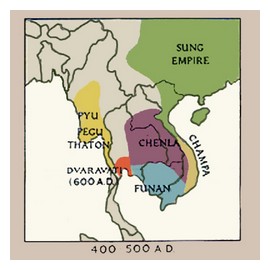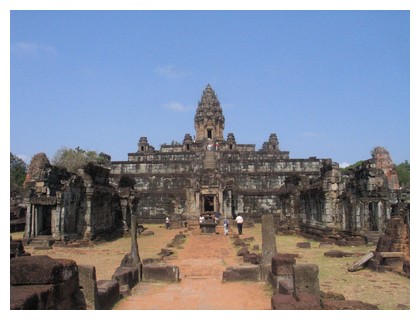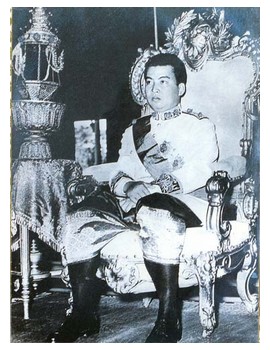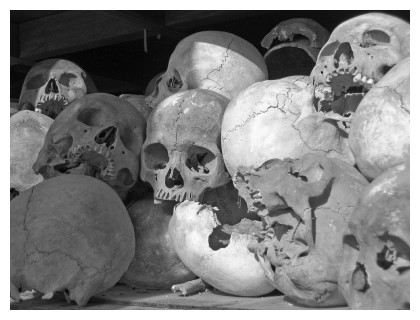- Funan Kingdom
- Chenla Kingdom
- Khmer Kingdom
- Rediscovery of Angkor
- During & the Aftermath of World War
- Cambodia in the Vietnam War
- The threesome: King Sihanouk, Lon Nol & Khmer Rouge
- Year Zero: 1975
- UN helps Cambodia

| ||||||||||||
|
Cambodia History
"A Simple Approach to History of Cambodia"
You will read about:
After Vietnam, it's one of the countries in Southeast Asia which has experienced the most (in my opinion). Here I've gathered the most important and relevant sections of the history of Cambodia. These sections are Cambodia facts which should be read because -
... Prepare yourself!
PS! I'm not a historian. This article is based on my understanding of the research
I've made from National Geographic (July Issue
2009) and
mekong.net.
I've only focused on the historical facts which I think are relevant and interesting. That's the reason you'll discover gaps in the timeline.
AD 68-550 (Funan Kingdom)
Funan was known as a powerful trading state and its borders stretched from Malay Peninsula to Burma.
550-800 AD (Chenla Kingdom)The Kings of Chenla took over the power after the Funans, and they worshipped the God of Shiva. 500-550 AD: Rudrawarman is the earliest recorded Khmer ruler. 700s AD: The Khmer fiefdoms are controlled by powerful families. This is the period when political tensions and battles for territory are set into motion.
From around AD 800-1431 (Khmer Empire)Founder of the Khmer Empire was Prince Jayavarman the 2nd. He unifies the rival fiefdoms and the capital Hariharalaya is established. Its ruins are known as the Rolous Group. Apsara dancing is believed to be introduced in the 1st century, and is inspired by Indian dancing arts. According to Princess Buppha Devi (daughter of King Norodom Sihanouk and apparantly the master of Apsara dancing), Apsara dancing was established in Cambodia a long time before Thailand. But when Angkor fell in the 15th century, the Apsara dancers were taken to Thailand.
Only kings and high priests can worship at the top of the hill temple Phnom Bakheng. 1011-1049: After a decade of wars between rival fiefdoms, Suryavarman the 1st wins the throne. He expands the empire's territory and starts constructing the West Baray. Angkor's barays were sacred sites and integral to the city's complex water system. What's the West Baray?
The real question is: To prevent drought, how do you ensure water after the monsoon period? The West Baray is a reservoir that's 5 miles long and 1.5 mile wide long! To ensure a steady water supply, stabilize the rice production, and control flooding, Khmer engineers built a network of canals, moats, ponds, and reservoirs. They directed the water through the canals, and into the barays and moats. And then the water finally drained into Tonle Sap -- the largest freshwater lake in Southeast Asia. Today, the baray is fed by water diverted from the Siem Reap River. From the 1060s: There are periods of territorial rivalries. 1113-1145: Suryavarman the 2nd builds Angkor Watt which he dedicates to the God Vishnu. He wins new land and strengthens diplomatic relations with China. From 1145/1150: Jayavarman the 7th is considered as the greatest Khmer king in Cambodia history.
He rebuilds the empire which has been torn by internal fighting and battle losses to Champa (today's Vietnam)! This is what he did for his country:
13th century: Therevada Buddhism becomes the official religion. 14th century: Armies from Champa to the east and Ayutthaya (today's Thailand) to the west are continuing to win Khmer land. The Thai army destroys Angkor Thom. 1431: Ayutthaya takes its own control of Angkor and installs a ruler.
1500sIn the mid 1500s it's time to renovate the temples in Angkor, where Angkor Wat has been abandoned and sadly falls into ruin. 1594: Thais take over the Khmer capital.
1860
But do have in mind that Angkor was already discovered by the Western world since the 16th century... Mouhot was apparantly the one who made the Angkor temples interesting by sketching and drawing the temples. 1863: King Norodom signs an agreement with France where Cambodia becomes a protectorate. But Cambodia gradually becomes a French colony.
1941
This is also the year when King of Cambodia - Norodom Sihanouk becomes king.
1945
After the Second World War, Norodom Sihanouk starts demanding independence from France.
1953 -- Independence Day!
1955Sihanouk's party The People's Socialist Community wins every seat in the parliament.
The dark period of Cambodia history starts...
1968The Khmer Rouge Party is established as the armed section of Communist Party of Kampuchea (CPK).
From 1960
- Don't think so. Sihanouk allows the Vietnamese in the North to use Cambodian soil for supplying the Viet Cong. Viet Cong was the army which fought the US and the South Vietnamese armies. The Viet Cong guerillas use sanctuaries in Cambodia to launch attacks on Southern Vietnam. This also means that weapon supply for the communist groups in Southern Vietnam runs through Cambodia! These sanctuaries are a pain in the ass for the Americans. And ironically, it leads to... US bombing of Cambodia's Eastern provinces where they believe Viet Cong guerillas are hiding. This means that thousands of Cambodians are killed.
1970 -- Bye, Bye Sihanouk!
Prince Sihanouk is overthrown in a coup, and General Lon Nol (prime minister) takes over the power. Sihanouk was not even in the country when Lon Nol convinced the National Assembly to depose Sihanouk as the head of state. To gain a bigger political support, Khmer Rouge does the "obvious" move: They want Sihanouk to join them. Sihanouk wants to revenge the betrayal of Lon Nol, and is persuaded to ally with the Khmer Rouge. But he has no idea that the Khmer Rouge has other plans for him... as in betrayal. The Viet Cong are told to leave, but instead they flee deeper into the jungle of Cambodia and are pursued by US and South Vietnamese troops. - Lon Nol reacts to the invasion from the Vietnamese communists and start their own fight. Cambodia turns into a battlefield, while Khmer Rouge are regrouping and taking over large areas because Lon Nol have his focus on chasing the Vietnamese soldiers away. Lon Nol has problems defeating the North Vietnamese and realises that he needs help from the US. But that doesn't turn out to be a clever move... The results are -
Can we really blame the fact that the Cambodians wanted the Khmer Rouge to take over the country...? Return to top of Cambodia History
Year Zero: 1975
Khmer Rouge guerillas ally with the Vietnamese communists and overthrow the government by marching into Phnom Penh. Pol Pot is the new Prime minister and the Communist leader of Khmer Rouge. The massacre of millions of Cambodians was about to begin
Year Zero basically means that Cambodia was converted into a pure Communist state centered on basic agricultural production.
Churches and temples were destroyed, intellectuals persecuted, currency was abolished etc. Educated persons were killed because they were perceived as the enemies. What I think is very sad is that young children were recruited as Khmer Rouge child soldiers. The results were execution and torture of Cambodian peasants and intellectuals, women, men and children. It is said that 1/3 of the Cambodian population was victim to genocide. Pol Pot starts to believe that cadres in the Eastern provinces are secretly allied to the Vietnamese. So he starts to execute Khmer Rouge party members of the Eastern Zone, the region bordering Vietnam. One of the men who gets away -- Heng Samrin,a Khmer Rouge military commander, joins the Vietnamese armies.
1978-1979Vietnamese are tired of what the Khmer Rouge are doing in Cambodia, and feels threatened because of Khmer Rouge attacks on their territory. So ultimately, 90.000 Vietnamese and 18.000 Cambodians invade Cambodia's borders and overthrow the Khmers. Heng Samrin is now running the government. The Khmer Rouge flees into the jungle near the Thai border. 1979: End of Khmer Rouge rule in Cambodia history
Click here to read about Killing Fields!
Interested in reading about the Killing Caves in Battambang?
1979-1990
Thousands of Cambodians flee to Thailand, and the sights of Pol Pot's brutality remind of the pictures you've seen of the Jews during Second World War... UN, Red Cross and other humanitarian organizations aid the refugees by the border. The tension builds up between UN and the new government of Heng Samrin, because the international community doesn't recognize Heng's government as the legitimate government of Cambodia, while Heng doesn't appreciate the fact that UN is aiding Khmer Rouge at the border. As a result of this, the aid to the internal Cambodia is proved to be difficult. The remains of Khmer Rouge are regrouping and launch attacks on the Vietnamese troops. The Vietnamese troops pull out in 1990.
1991 - UN steps inUN as well, is worried about the unstable situation in Cambodia, and decides to place 16.000 peacekeeping forces and administrative support. Heng Samrin is replaced by Chea Sim. The Khmer Rouge doesn't give up: They start kidnapping UN peace keepers, and some of them get killed. And they even step up the attacks on innocent civilians, and plant even more land mines in the rural areas of the country.
1993-2004Sihanouk is reinstated as king of Cambodia in 1993, but because of his health issues he declares the abdication of his throne.
1997Rumours that Khmer Rouge leaders want to start peace negotiations begin, and it results in one of Pol Pot's mistakes: Pol Pot executes his Defense minister, Son Sen and 10 members of Son Sen's family. This execution splits up the remaining fighting spirit in Khmer Rouge. Pol Pot is later overthrown in an internal rebellion in the fall of 1997, and he's convicted in a Khmer Rouge show trial.
April 15, 1998
2009 - OngoingWar crime trials against former Khmer Rouge started in 2009. The first case was opened in February 2009 against Duch - former commander of the S-21 prison. He was convicted of his war crimes in 2010. He was sentenced to 35 years in prison, but had 11 years shaved off. The sentence was appealed by the prosecutors who thought the sentence was too mild, while Duch thought it was too harsh. In June 2011, in the second phase of the proceedings, four of the remaining Khmer Rouge leaders went on trial. In 2011, a conflict arose between foreign judges of the tribunal, prompting at least four of the foreign judges to resign. They said that the government was trying to block prosecutions.
You can read more about it here at NY Times
Backpacking Tips Home
Cambodia Facts Main
Cambodia History
Don't know how to make an itinerary?
|
||||||||||||
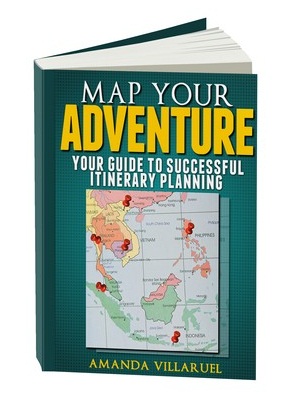
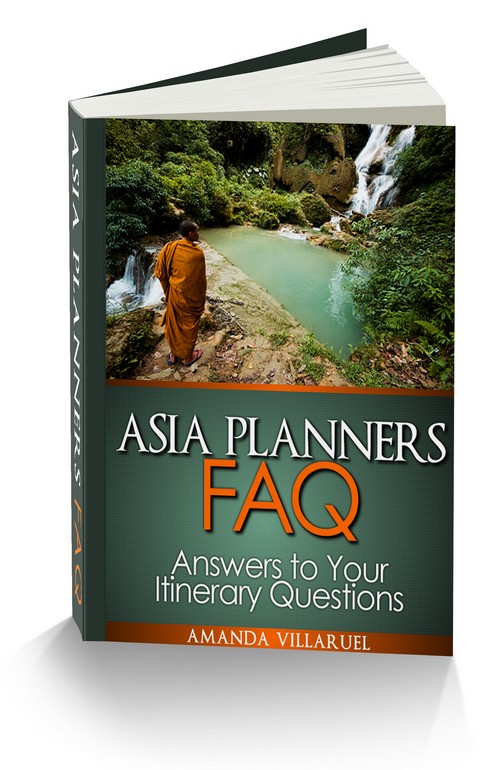
|
You'll be surprised to learn that itinerary-making can be fun and easy.
This book is made for you, with 70 pages of itinerary tips and maps, time tables and must-see destinations in the region :-)
Read more about Map Your Adventure here
"Asia Planners FAQ" is a supplement to "Map Your Adventure" and a compilation of real questions from visitors and answers from travel experts on itineraries found on Backpacking Tips Asia.com. You'll find your answers in this ebook.
Search this site
Recommended Books on History of Cambodia
Connect with
Backpacking Tips Asia
